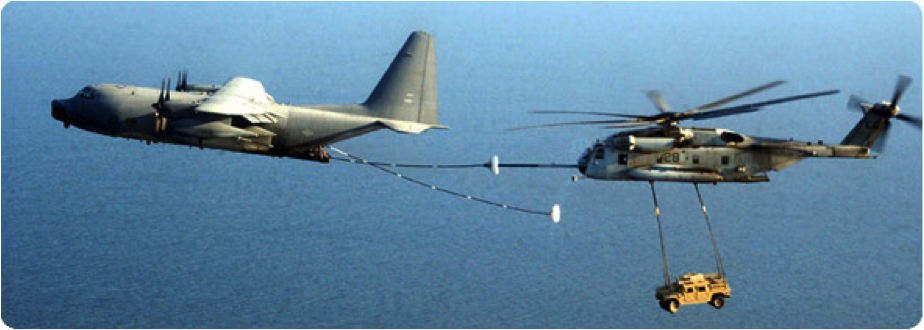Posted on February 21, 2012

Pacific Aviation Museum’s newest aircraft is a Sikorsky CH-53D Sea Stallion, S/N 157173. The CH-53 has been the Marines’ heavy lift helicopter since the days of the Vietnam War. Our aircraft was commissioned in December 1969 and quickly went to Vietnam. It crashed on Oct. 30, 1970, but was retrieved and placed back in service. Since then, this bird has served in most major conflicts, most recently in Afghanistan. Until its recent retirement, it belonged to Heavy Marine Helicopter Squadron HMH-362 at Marine Corps Air Station Kaneohe Bay. The squadron’s nickname, the “Ugly Angels,” is a comment on the CH-53’s boxy Bulldog appearance. Today, the Marines have transitioned out of most of their CH-53Ds and are trying to extend the lives of the CH-53Es to stay in service until the CH-53Ks arrive sometime around 2018. The CH-53 is the largest helicopter outside Russia, yet Marines have shown that it can be rolled and even looped.
The USAF has also used the CH-53 widely. In Vietnam, the HH-53B and HH-53C were the “Super Jolly Green Giants” that rescued downed air crews deep in enemy territory. After Vietnam, MH-53H, MH-53J, and MH-53M Pave Low helicopters inserted and extracted special operations forces and led the first attack in Desert Storm.
Marine Stallions

CH-53D Unloading Troops
At the beginning of the Vietnam War, the Marines needed a heavy lift helicopter to supplement their new Boeing Vertol CH-46 medium lift helicopters. They chose the two-engine Sikorsky CH-53A Sea Stallion. After producing 139 CH-53As, Sikorsky began producing 126 CH-53D Sea Stallions. The Delta model was muscular helicopter with two 3,925 shp engines. This allowed it to carry heavy loads yet still be one of the fastest helicopters in the war.

CH-53Ds in Hawaii
Rather than give maximums for performance parameters, Table 1 shows performance in two of the mission profiles the CH-53D was designed to fly. The first is an ordinary assault mission carrying 8,000 pounds of inbound cargo internally and taking back 4,000 pounds. The second is an overload assault mission, in which the outbound load was a 12,742 pound external slung load. Note that even with an external load adding drag, the CH-53D was still a fast helicopter. Its two 3,925 shp GE turboshaft engines gave it exceptional performance for its time.
Table 1: CH-53D Performance Characteristics on Assault Missions
| Loading Condition | Basic Assault Mission | Overload Assault Mission I: |
| Mission Description | Fly an internal cargo of 8,000 pounds 115 statute miles, hover for ten minutes, unload the cargo, and pick up 4,000 pounds of internal cargo for the return trip. | Fly an external cargo of 12,742 pounds 109 statute miles, hover for ten minutes, unload the cargo, and pick up 4,000 pounds of internal cargo for the return trip. |
| Maximum Take Off Weight (pounds) | 36,693 | 41,435 |
| Maximum Speed at Altitude (mph) | 191 | 181 |
| Cruising Speed (mph) | 173 | 173 |
| Total Mission Time (hrs) | 1.48 | 1.4 |
| Fuel Reserve | 10% | 10% |
Today, only a few heavy Marine helicopter squadrons still fly the CH-53D, and they are transitioning to the newer Echo model. This should have happened several years earlier, but delays in the production of the CH-53K model discussed below extended service longer than desired.

CH-53D Super Stallion

Loaded CH-53E Refueling
After Vietnam, the equipment that helicopters needed to carry grew larger and heavier. The Marines determined that they needed a helicopter with 80% more lift. This would allow it to sling the 16,000 pound M198 howitzer and the 26,000 Light Armored Vehicle. It is often said that the new aircraft was required to lift 16 tons, but this was only for missions with very small radiuses. Overall, it seems best to call the required aircraft a 10-ton hauler.
Sikorsky responded to these requirements by developing a version of the Sea Stallion with higher engine power of 4,380 shp and adding a third engine. This required a more powerful rotor system, the use of titanium-fiberglass composite, and the addition of a seventh blade. To give the helicopter more cargo space, Sikorsky lengthened the fuselage by six feet. With a maximum takeoff weight of over 73,000 pounds (almost twice the maximum weight of the Delta model), the CH-53E Super Stallion is the heaviest helicopter outside of Russia. The CH-53E finally entered service in 1981. The Marines and the Navy eventually purchased 177 Super Stallions through 1994, when production ended. The Echo model remains in widespread use by the Marines today. It has served the Corps well in all wars since its creation. Today, the Marines are trying to stretch its useful life until the CH-53K is ready.

Today, the Marines are planning to move to the even more powerful CH-53K. This is a thoroughly redesigned aircraft. It will use composites heavily, will have blades with downward aerodynamic tips, and will have a glass cockpit. It will be about 12% wider than the Echo model, in order to carry wider cargo like the HMMWV. Although the Kilo will be more complex than earlier models, it should have about 40% lower maintenance requirements. The CH-53K will be powered by three GE-38-1B engines, each rated in the “7,500 shp class”. The Kilo will be 20 mph faster than the Super Stallion yet will be able to carry a load of 27,000 pounds with a radius 126 miles, even in hot and high conditions. This is more than double the carrying capacity of the CH-53E under these conditions.
CH-53K

CH-53K Mock-up

Artist Rendering of a CH-53K in flight
Unfortunately, the CH-53K will not reach Initial Operational Capability until 2018. A serious question is whether the Marines can safely stretch their CH-53Es Super Stallions long enough to bridge the gap between today and the CH-53K’s arrival. This problem is exacerbated by the duty cycles required in Afghanistan, which are about three times normal peacetime duty cycles.
Navy Stallions and Dragons
The Navy also liked the CH-53. It modified 15 CH-53As to become RH-53As for minesweeping operations. When the D model arrived, the Navy began to procure RH-53Ds. These minesweepers trailed equipment that dragged underwater mines to the surface. Gunners then detonated the mines with 12.7 mm machine guns. Later, MH-53E Sea Dragon took on minesweeping duties. Mine sweeping was crucial several times in the Gulf, especially in 1987 and 1991.
Beyond minesweeping, these versatile helicopters were used for transportation, combat search and rescue, vertical replenishment, and even towing ships. Unfortunately, RH-53Ds failed sadly in Operation Eagle Claw operation in 1980, which was an attempt to retrieve U.S. hostages in Iran. Two were turned back by a dust storm, so after the strike team landed in a staging area, the mission was aborted because it had too few helicopters. When the strike team was leaving the staging area, one of the RH-53Ds struck a Hercules on the ground. Eight soldiers died, and the mission was aborted.

Operation Eagle Claw Wreckage of an RH-53D
Air Force Super Jollies
In Vietnam, the USAF had a pressing need for combat search and rescue (CSAR)—finding and retrieving pilots shot down in enemy territory before the enemy found them. The Air Force first used the Kaman HH-43B, but this small helicopter had very limited range and a cruising speed of only 105 mph. The Air Force then turned to the U.S. Navy’s Sikorsky H-3 helicopter. The Air Force procured the HH-3E, and the new “Jolly Green Giants” immediately proved their worth. However, the HH-3E still had limited speed; this dragged out the time required for extractions, sometimes with fatal results. In addition, in the hot and often high-altitude environment of Vietnam, the HH-3E Jollies sometimes lacked the power to hover to retrieve air crews needing extractions.

HH-3E Jolly Green Giant
The Air Force then turned to the Marines’ H-53. The HH-53B and HH-53C Super Jollies had no problem hovering under any conditions, were more heavily armed, and carried around 1,000 pounds of titanium armor. Both models had retractable in-flight refueling probes. This allowed them to refuel from C-130 tankers that flew along on long CSAR missions. The HH-53B, which was a modified CH-53A, arrived in 1967. However, the Bravo model was an interim solution, and only 8 aircraft were produced. The improved HH-53C arrived in Vietnam late in 1968. The Air Force purchased 44 of them.
Compared to the HH-3E, which had a normal internal load of 3,000 pounds, the HH-53C could carry 13,000 pounds. While the HH-3E had a top speed of 142 knots, the HH-53C raised this to 190 knots. Higher speed allowed the Super Jollies to get to crash scenes considerably faster than the HH-3E Jollies. The Super Jollies had three six-barrel GAU-2/A 7.62 mm miniguns—one on each side and one shooting out the back ramp.

HH-53C Jolly Green Giant in Vietnam, Taken from another CH-53C
Air Force Pave Low Helicopters

CH-53M Pave Low IV
Although the Super Jollies were safer than the H-3E Jollies for CSAR missions, they were far from safe. Of the 52 HH-53Bs and HH-53Cs used in Vietnam, 17 were lost in combat and another 3 were lost in accidents. This does not even include aircraft were shot down but returned to duty.
Although the HH-53 Super Jollies were great aircraft, they were only adept at operating in the daytime and in good weather. This was obviously bad for retrieving downed air crews. It was even worse for another job taken on by the Jollies and Super Jollies—inserting Special Forces teams behind enemy lines, resupplying them, and retrieving them. Night versions of the Super Jollies were needed.
After Vietnam, vision and navigation technology gradually matured. In 1980, the USAF rebuilt nine of its Vietnam H-53 aircraft as MH-53H Pave Low III multi-mission helicopters. “Pave” is an acronym for precision avionics vectoring equipment. “Low” referred to the fact that these electronics allowed the aircraft to fly though enemy air spaces flying nap of the earth to avoid detection. The MH-53H was followed by more advanced MH-53J Pave Low III Enhanced helicopter, 41 of which were produced from older helicopters from 1986 to 1990. Like the H, the J model was rebuilt from older models. In the late 1990s, the Air Force began to receive MH-53M Pave Low IV Helicopters with the ability to understand the entire battlefield through satellite links.
We will never know most of the missions these aircraft and their Special Forces passengers completed, but one example is very well known. At the start of Desert Storm, the U.S. wanted to knock out two Iraqi radar stations, clearing a corridor for later aircraft to use to enter Iraq. It was decided to use four U.S. Army AH-64 Apache helicopters against each of the installations. However, the Apaches did not have good enough navigation equipment to take them to the radar sites. Consequently, each group of four Apaches was led to the target by an MH-53J. This worked very well, and when the U.S. attack officially began at 3:00 am Baghdad time, the corridors were free to use.

Pave Lows in Transit

MV-22 Osprey


